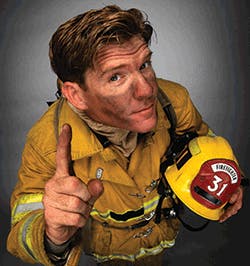Just because a facility has developed contingency and response plans for chemical spills, explosions, fires and other major incidents doesn't mean that it's completely prepared for emergencies. Without a comprehensive business continuity plan in place, factors that are beyond a facility's control – such as hurricanes and virus pandemics – can disrupt operations and bring a business to its knees.
Unlike contingency and response plans that outline the actions to take immediately after an emergency, business continuity plans (BCPs) detail the steps that a facility will take to fully recover from an incident. They also provide guidance on how to maintain communication with employees, customers and stakeholders; how to work with limited resources (utility services and personnel, for example); and how to recover or restore facility assets after disasters.
A business continuity plan is comprehensive and encompasses every facet of a business operation. Consequently, creating and maintaining one can be a time-consuming exercise. However, without a BCP, a facility might waste precious time deciding what to do in the wake of emergency, and might do further damage to the business by making poor, on-the-fly decisions.
When it comes to rebuilding after a tragedy, it's easy to think, "We have insurance to cover that." Unfortunately, while insurance is essential and will help cover the cost of repairs or replacement items, it's not a substitute for thorough planning – and won't help a facility address essential communication needs.
Elements of a Communication Plan
In the aftermath of a disaster, the success or failure of a response and recovery plan often hinges on communication.
If the power goes out, the production manager needs to know when it will be restored. If a bridge collapses, the entire community needs to know when it will be rebuilt and how to get around it. Large-scale disasters compound these needs and can exhaust traditional communication resources in short order.
Even with an event as isolated as a fire, the area around a facility can lose electricity and landline phone service for an extended time period. And the surge of calls from family members checking on the whereabouts of their loved ones can overwhelm cellphone towers in the immediate area.
In many facilities' emergency response plans, communication involves evacuation alarms and a checklist to ensure that all employees safely reach the gathering point. Because a BCP is more than just a response tool, a good communication plan should be more comprehensive and multi-faceted, and should encompass communication with:
– Employees
While some people might consider it invasive, facility managers need a way to contact employees when they're away from the plant. They also need a way to contact family members if something happens that involves a loved one.
Having current contact information can help managers check on each employee after tornadoes, hurricanes and other disasters to see if the employees and their families are safe or if they need anything.
As employees become more comfortable with disaster communications, employers can expand BCPs to include training on personal and family preparedness. Topics such as how to shelter in place and how to build a 72-hour kit help everyone to be more prepared.
Employers also need to teach workers how to deal with the media. Usually, it's not a good idea to let everyone talk to the media, so employees need to know what to say, how to say it and where to direct media inquiries. This helps ensure that the right people (such as designated staff members who've been trained to handle media requests) are sharing information that's timely and consistent.
– The Community
Understandably, people want to know how a disaster is going to affect them. Facilities – especially those that could release hazardous chemicals or those where explosions could occur – benefit from having pre-planned messages as well as information on any hazardous chemicals or processes used at the facility. Incorporating this information into a BCP is valuable during emergencies, because the information is ready to share immediately with reporters who are trying to meet tight editorial deadlines.
Speaking of the media, establish relationships with local radio and TV stations before a disaster occurs, so they can get to know their media contact at the facility. This allows the media to become familiar with the facility and any specialized processes. Providing media kits that contain factual information about the facility's chemicals and processes is another way to minimize the chance of extraneous or bad information being broadcast in the chaotic aftermath of a disaster.
– First Responders
An emergency isn't the best time to meet the local fire chief, police chief or EMS director for the first time.
In a facility-specific disaster, local responders can provide vital resources quickly. In a community-wide disaster, they might need information from the facility quickly. Inviting local first responders to participate in onsite drills is beneficial for the responders and the facility, giving both parties an opportunity to become familiar with their respective needs and capabilities.
In some areas, local emergency management offices can assist with evacuation-zone mapping and plan-writing. They also can help establish relationships with mass-transit organizations, hospitals and other local resources that might be needed after an incident.
– Utility/Service Providers
If the electricity is out for an extended period of time, it likely will be difficult to obtain a backup power generator. If telephone lines and cell towers are out, satellite providers might be overwhelmed with requests for new services. Even office and warehouse space that has been available for years can become a precious commodity after a disaster.
How long it takes to restore electricity and phone service after a disaster could depend on providers' priorities. For example, utility and service providers might be under intense pressure to restore power and landlines to hospitals and critical-care centers – which could leave providers with limited resources to bring other areas online.
Being able to communicate with service providers can help establish a realistic timeframe, enabling managers to make informed decisions – such as whether to wait or move operations to an alternate site to meet production deadlines.
– Suppliers
Maintain accurate contact information for all suppliers. Know their shipping and payment terms as well as lead times and (where possible) stock levels. Regardless of whether a disaster destroys a call center, a production site or a warehouse (or all three), your supplier base is a lifeline on which you'll rely to restore materials quickly.
Establishing solid communication with suppliers can mean the difference between being able to replace 100 new computers and headsets in one or two days and having to source each unit separately with a credit card on a two-week (or longer) lead time. Some suppliers also might be willing to extend payment terms or offer accommodations to help the facility rebuild and recover after a disaster.
– Customers
In this digital age, people can find just about anything they want or need via a quick search on their laptop, smartphone or tablet. With the rise of just-in-time and lean manufacturing, many companies don't maintain large quantities of stock, potentially making it more difficult to replenish your ready-to-sell products after a disaster.Even loyal customers might not be willing or able to wait several months for parts or supplies. Knowing how long it will take to restore or relocate operations enables the facility to provide customers with accurate information about lead times, and can help maintain loyalty during the facility's recovery period.
Developing plans to communicate with various stakeholders after a disaster can help a facility minimize chaos and restore order. It also can help the business recover faster, more effectively and more safely.
Karen D. Hamel is a technical specialist for New Pig Corp. She has more than 20 years of experience helping EHS professionals meet EPA, OSHA and DOT regulations. Contact her at (800) 468-4647 or at [email protected].


